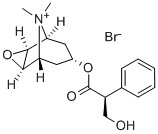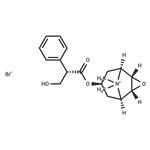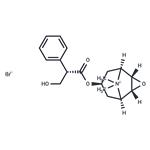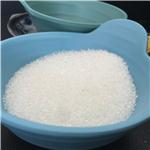Chemical Properties
Methscopolamine Bromide is an anticholinergic, which occurs as white crystals, or as a white odorless crystalline powder. It melts at about 225°C with decomposition. The drug is freely soluble in water, slightly soluble in alcohol, and insoluble in acetone and in chloroform.
Originator
Pamine,Upjohn,US,1953
Uses
Methscopolamine bromide is the methylated derivative of Scopolamine, a muscarinic antagonist that is similar to acetylcholine. It have been used for the treatment of peptic ulcers by reducing acid secretion of the stomach and is used to treat morning sickness.
Definition
ChEBI: Scopolamine methyl bromide is a quaternary ammonium salt resulting from the reaction of the amino group of scopolamine with methyl bromide. It has a role as a muscarinic antagonist, an antiemetic, an antispasmodic drug and a parasympatholytic. It is a quaternary ammonium salt and a bromide salt. It is functionally related to a scopolamine.
Application
(-)-Scopolamine methyl bromide was administered to rats to inhibit the peripheral cholinergic effects induced by pilocarpine.
Manufacturing Process
In a one-liter separatory funnel, 94 g (0.215 mol) of scopolamine
hydrobromide trihydrate was dissolved in 250 ml of water, made alkaline by
shaking with 40 g (1 mol) of sodium hydroxide in 150 ml of water, and the
free base immediately extracted with ether. As scopolamine is somewhat
soluble in water, the aqueous layer was saturated with potassium carbonate
and again extracted with ether. The combined ether extracts were dried over
anhydrous magnesium sulfate and the ether removed by distillation, leaving
65 g (0.214 mol; 100% yield) of nearly colorless oil. Then 100 g (1.05 mols)
of cold methyl bromide was added to a chilled, 500-ml pressure flask
containing the 65 g of scopolamine, the flask stoppered tightly with a clamp,
and allowed to stand at room temperature for 96 hours.
The flask was cooled before opening, excess methyl bromide removed by
filtration, and the white solid washed thoroughly with dry ether. The yield of
crude scopolamine methyl bromide was 80g (94% yield; 93.5% over-all
yield).
The salt was recrystallized from 550 ml of alcohol; first crop, 70 g, MP 212° to
214°C; second crop, 6 g, MP 195° to 200°C. The combined crops were again
recrystallized from 500 ml of 3-A alcohol; MP 210° to 212°C. The third
recrystallization from 600 ml of alcohol yielded 64 g, MP 214° to 216°C, a
75% yield based on scopolamine hydrobromide trihydrate starting material.
Therapeutic Function
Spasmolytic
Biochem/physiol Actions
Competitive muscarinic acetylcholine receptor antagonist.
Mode of action
methscopolamine bromide is used to treat gastrointestinal disorders such as peptic ulcers, irritable bowel syndrome, and stomach cramps. Its mechanism of action involves blocking the action of acetylcholine on smooth muscle cells in the digestive tract, thereby reducing spasms and increasing motility.
References
[1] ANDRé ROBERT JAMES E N. Effect of an anti-acetylcholine drug, methscopolamine bromide, on ulcer formation and gastric mucus[J]. Journal of Pharmacy and Pharmacology, 1964, 16 10: 690-695. DOI:
10.1111/j.2042-7158.1964.tb07388.x.
[2] M A WASSERMAN R L G. Bronchospasmolytic effects of methscopolamine bromide.[J]. Journal of Pharmacology and Experimental Therapeutics, 1979, 211 1: 159-166.
[3] J A DANIEL. Methscopolamine bromide blocks hypothalamic-stimulated release of growth hormone in ewes.[J]. Journal of animal science, 1997, 75 5: 1359-1362. DOI:
10.2527/1997.7551359x.





